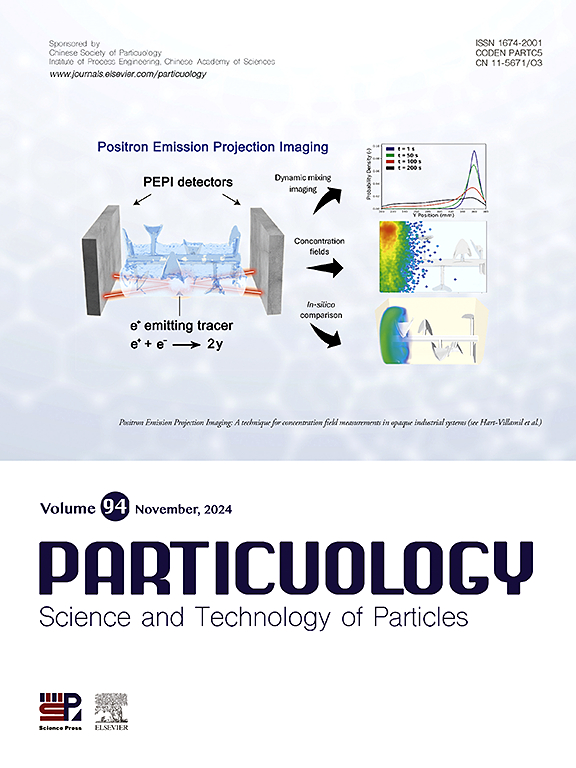复合导电剂用量及炭黑与石墨烯质量比对锂离子电池浆料网络结构的影响
IF 4.3
2区 材料科学
Q2 ENGINEERING, CHEMICAL
引用次数: 0
摘要
研究了复合导电剂用量和炭黑(CB)与石墨烯(Gr)质量比(m’CB:m’Gr)对锂离子电池(LIB)浆料网络结构的影响。选用φcom1 = 0.25%、φcom2 = 0.5%、φcom3 = 0.75%、φcom4 = 1%四种不同掺量的复合导电剂作为LIB浆料的导电材料。同时,为了区分CB和Gr的个体影响,还选择了两个不同的CB与Gr的质量比,即m 'CB: m 'Gr = 1:2和m 'CB: m 'Gr = 2:1。此外,还研究了与复合导电剂用量相同的单一导电添加剂CB或Gr对LIB浆料网络结构的影响。利用电化学阻抗谱(EIS)、扫描电镜(SEM)和拉曼光谱(Raman)实验分别获得了LIB浆料的电化学、形态和拉曼表征。通过对实验结果的分析,得出的主要结论是:CB与Gr的协同作用使得导电剂用量最小化,LiCoO2颗粒用量最大,从而保证了较高的导电效率,从而有可能大幅提高锂离子电池的能量密度。本文章由计算机程序翻译,如有差异,请以英文原文为准。

Clarification of network structure of lithium-ion battery slurry under effects of composite conductive agent amount and carbon black to graphene mass ratio
This paper clarified the network structure of the lithium-ion battery (LIB) slurry under effects of composite conductive agent amount and carbon black (CB) to graphene (Gr) mass ratio (m’CB:m’Gr). Four different amounts of composite conductive agent which are φcom1 = 0.25%, φcom2 = 0.5%, φcom3 = 0.75% and φcom4 = 1% are selected as the conductive materials for LIB slurries. Meanwhile, to discriminate the individual impacts of CB and Gr, two distinct mass ratios of CB to Gr, namely, m’CB: m’Gr = 1:2 and m’CB: m’Gr = 2:1, are additionally chosen. Moreover, the influence of single conductive additive agent CB or Gr with the same amount as composite conductive agent on the network structure of the LIB slurry is also investigated. Furthermore, Electrochemical Impedance Spectroscopy (EIS), Scanning Electron Microscopy (SEM) and Raman experiments are performed to obtain the electrochemical, morphological and Raman characterizations of LIB slurry, respectively. After analyzing the experimental results, the main conclusion shows that the synergistic interaction between CB and Gr ensures a high-level conductive efficiency because of minimizing the amount of the conductive agent and increasing the amount of LiCoO2 particles to the utmost degree, which has the potential to substantially elevating the energy density of LIB.
求助全文
通过发布文献求助,成功后即可免费获取论文全文。
去求助
来源期刊

Particuology
工程技术-材料科学:综合
CiteScore
6.70
自引率
2.90%
发文量
1730
审稿时长
32 days
期刊介绍:
The word ‘particuology’ was coined to parallel the discipline for the science and technology of particles.
Particuology is an interdisciplinary journal that publishes frontier research articles and critical reviews on the discovery, formulation and engineering of particulate materials, processes and systems. It especially welcomes contributions utilising advanced theoretical, modelling and measurement methods to enable the discovery and creation of new particulate materials, and the manufacturing of functional particulate-based products, such as sensors.
Papers are handled by Thematic Editors who oversee contributions from specific subject fields. These fields are classified into: Particle Synthesis and Modification; Particle Characterization and Measurement; Granular Systems and Bulk Solids Technology; Fluidization and Particle-Fluid Systems; Aerosols; and Applications of Particle Technology.
Key topics concerning the creation and processing of particulates include:
-Modelling and simulation of particle formation, collective behaviour of particles and systems for particle production over a broad spectrum of length scales
-Mining of experimental data for particle synthesis and surface properties to facilitate the creation of new materials and processes
-Particle design and preparation including controlled response and sensing functionalities in formation, delivery systems and biological systems, etc.
-Experimental and computational methods for visualization and analysis of particulate system.
These topics are broadly relevant to the production of materials, pharmaceuticals and food, and to the conversion of energy resources to fuels and protection of the environment.
 求助内容:
求助内容: 应助结果提醒方式:
应助结果提醒方式:


